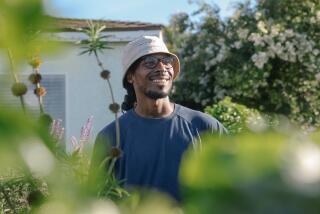Berries, Peas Make Trained Bedfellows in a Rooftop Tub
- Share via
My wife grows all the vegetables we need, plus fruit trees and berries, on an apartment building’s garage rooftop in the middle of Hollywood. It is no small garden, measuring 50x100 feet, but everything grows in containers, more than a hundred of them in all shapes and sizes.
One of Shirley’s favorites is something not often grown in a container. In a 1x3-foot box she grows boysenberries, and because container gardeners often must strive to make the most of the space they have for gardening, she also grows edible podded peas and a few quick-maturing vegetables in the same container.
This small-space garden almost always gets attention from visitors. Berries and peas sharing the same small container may seem unlikely, but they have been growing together for three years, one producing while the other is dormant.
The boysenberry bears over a period of two months and the berries are large and sweet. However, fruiting doesn’t occur until the second season.
Root, Crown and Canes
Boysenberries consist of a root system, crown and canes. The crowns are perennial; new canes arise from them every year. The canes are biennial; they live for only two years. During the first year canes grow and send out laterals, or side branches. The second year, small buds form on these laterals, fruiting shoots grow from these buds and then bear fruit in early summer. After fruiting, these 2-year-old canes die and must be cut away.
Here’s how to set up a container:
Start with a sturdy container (sealed or lined with plastic), 1 foot wide by 3 feet long and 12 inches deep. You could build it out of 1x12 redwood boards. Three or more holes are needed in the bottom for drainage. Firmly attach a 7-foot-high, 3-foot-wide vertical frame, which will make the container resemble a tool box with a tall handle. Place the box where it gets at least four hours of sun a day.
On each of the 3-foot sides of the box, near the top, hammer 12 equally spaced nails. Run wires over the top of the vertical frame and fasten them to the nails, forming a wire trellis for the peas to climb later; the boysenberry is simply draped over the frame.
Shirley has her own special recipe for potting soil: Take 1 1/2 bags of commercial potting soil (each bag contains 2 cubic feet) and add 6 gallons of compost, one-half cup of bone meal, one-quarter cup of kelp meal and 2 gallons of horse manure.Mix well. When filling the container, stop every four inches and water thoroughly, so you are sure the potting soil is wet.
Shirley also replenishes the potting soil at least once a year by removing by hand about three to six inches of soil and replacing it with a mixture that is mostly her own composted organic matter, mixed with a little bone meal, kelp meal and chicken manure.
Our boysenberry was purchased in a 1-gallon can with perhaps one to three young canes, but more young canes grew from the crown in the next few weeks. Allow no more than eight canes to continue to grow; prune away the rest.
When the canes are 3 feet long, pinch off the ends with thumb and forefinger--this encourages branching. These branches (laterals) are allowed to grow off the trellis and sprawl across the rooftop. They will grow very long, but won’t produce fruit the first year.
Opportunity for Vegetables
They will not need to be trellised until they start the fruiting cycle, so vegetables may be grown in the container with them the first summer. Beans are a good choice, because they grow up the trellis.
During the winter when the berry canes are dormant is when you can grow the edible-podded peas. Planted in the fall, they will be finished by the time the berry needs the trellis.
In February of the second year, the boysenberry laterals will begin their fruiting cycle. They are still very long so are cut back to 10 feet. Then they are draped the length of trellis--hanging over each side.
Buds appear on the laterals and fruiting shoots grow from them. Near the end of these shoots clusters of berries will appear--on ours, about May 15.
The harvest is over by July 15, according to Shirley’s notes, and now it’s time to cut away the canes that fruited, saving the new ones that grew in early summer from the crown.






